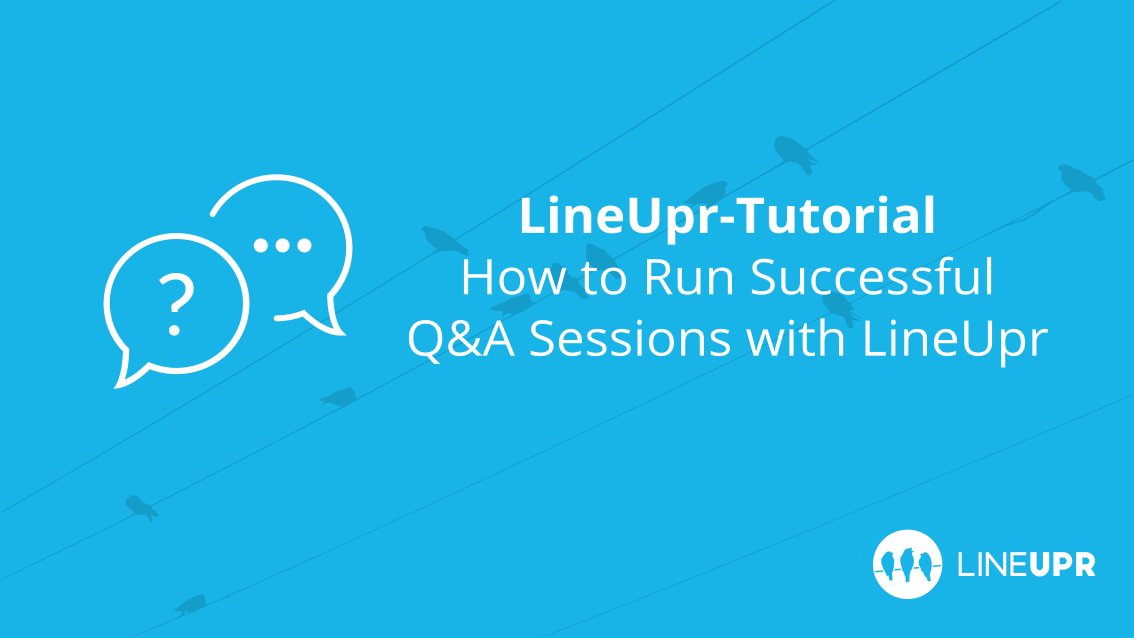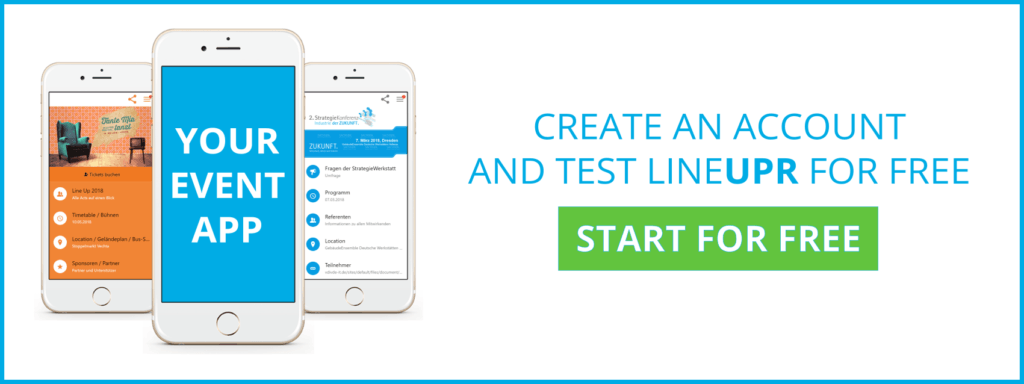Reading time: 5 minutes
Q&A stands for Questions and Answers. Q&A sessions are great for picking up your participants and integrating them into your event. Although head-on presentations also have their charm, what could be better than asking the speaker one’s personal questions? After all, each of us has our topics and priorities.
In general, Q&A sessions are highly recommended and have a number of benefits for you as an event organizer. Unfortunately, there are a few stumbling blocks to consider in the implementation. But do not worry. After reading this article you will be optimally prepared and nothing will stand in the way of a successful Q&A session.
What Is a Q&A Session and How Does It Work?
During a Q&A session, your participants can ask individual questions to the speaker, moderator or you. This is often done immediately after a presentation or during a panel discussion. Depending on the format, the questions are answered directly by the addressed person or a moderator opens the questions in a debate.
Q&As are not a recent invention but instead, have always been part of the solid repertoire of any good conference. However, the development of event technology has given this idea a whole new momentum. It has never been so easy for organizers to gather questions from the audience anonymously and quickly.
In the past, participants first had to catch the speaker’s eye and when they were subsequently selected, they had to yell their question through the room. Firstly, the selection process alone consumes valuable time, and secondly, few people dare to expose themselves in this way. Many are afraid of embarrassing themselves. With the introduction of microphones, no one had to scream anymore but still, the fear of embarrassment was there. Besides, the selection process was even longer since the microphone must first be brought to the person asking the question.
With the use of event apps, these issues are now history. With LineUpr you can create a Q&A survey in a few seconds and unlock it for your participants. They can then anonymously and with a few clicks ask their questions through the app directly to the speakers. You can publish these questions live (via a beamer or screens) or you can give your moderator access to the questions and the moderator can put up them on behalf of the participants.
With LineUpr, participants can enter their questions quickly and anonymously. You, the organizer, can publish the questions live or select them directly. Participants are no longer afraid of asking a stupid question or embarrassing themselves. You do not have to pick anyone or send your staff running through the hall. Also, questions can be collected in parallel, allowing your speakers to choose from a large pool.
Why You Should Definitely Use Q&A Sessions
There is hardly an easier way to integrate your participants into the event programme than with Q&A sessions. At the same time, it also saves you a lot of work and time in event planning.
Firstly, your participants can ask their individual questions. We all have a very subjective view of the world, so we are also interested in different aspects. As an organizer, you can rack your brains for weeks wondering which questions your attendees will want to have answered or you can just let them ask questions themselves.
Secondly, you do not have to think up questions on your own. As already mentioned, the participants do this for you. Sure, you should always have a few general questions in the back of your mind but you’re saving yourself a lot of work and time.
Thirdly, your speakers are challenged. If you think up the questions yourself, then in 99% of the cases you will be asking the standard questions your speakers have heard a hundred times. The answers are routine and you will not learn anything exciting. If the participants ask their own questions, then in 90% of the cases there will also be classic questions but only from the crowd will there be some interesting questions. The speakers are required to answer these questions and they have to answer spontaneously. Here, real gold nuggets often come to light for all participants.
Risks and Disadvantages of Q&A Sessions
Unfortunately, there are some stumbling blocks which you should keep in mind when it comes to Q&A sessions.
Your participants don’t ask any questions. An absolute catastrophe. You prepared everything so well and the speaker is ready for questions but your audience remains silent. This can quickly become embarrassing for the speaker or for you. In this case, you should have a few questions in the back of your mind to avoid a bumpy start. You often only need one point for the discussion to start. If the speaker starts, the questions usually come by themselves.
If you decide to use LineUpr for the Q&A session, then this problem should only occur in the first few seconds. Since the participants can submit their questions anonymously and very easily, even very shy people dare to join in. This problem is much more common in the classic approach with the microphone and standing up in front of everyone else situation.
Another risk is an inappropriate question. Since your participants decide for themselves which questions they ask then there can, of course, be unpleasant questions. What is rude in this example depends heavily on the speaker. As an organizer, you have two options in this case. If you decide to present the questions live, then you should first make it clear to your participants which types of questions are allowed or which topics may be taboo (in this case, you should be aware that this may also lead to the problem that such questions are then asked). Or you decide against the live version and your moderator chooses the questions. But again, you should explain to the participants in advance which questions are allowed and which are not. In this way, you can avoid having disappointed participants.
8 Tips for Successful Q&A Sessions
Lastly, we have summarized our top 10 tips so that everything goes according to plan during your Q&A sessions
Before the event:
1. Prepare your moderator or speaker
Your moderator or speaker should know precisely how the Q&A session runs so that nothing goes wrong on stage. So explain the exact process to them and show them how the participants can enter their questions and how the questions ultimately end up on the stage. If a little more time is available, then the process should definitely be rehearsed.
2. Connect your moderators with the speakers
If you are working with a moderator and a speaker, it is necessary that both have a short talk beforehand so that they can get a feeling for each other. On the stage, both should ultimately work as one unit. Again, you could do a small rehearsal where your moderator asks one or two questions to the speaker.
3. Prepare a few questions yourself
Sometimes starting a Q&A session can be a bit bumpy. In this case, you should prepare some warmup questions. The speakers can start relaxed and at the same time, you give your participants a starting point for further questions.
4. Clear time concept
You should allow enough time for the questions and answers. Such a session is actually really useful for only about 10 minutes. Your participants ultimately want to ask all of their questions.
5. Clear instructions for the event’s technic
The technical department should be well informed about the ways in which the participants can ask their questions and how they should be published afterward. During the session, the technician and presenter have no opportunity to communicate with each other. Therefore everything should be agreed on before.
During the event:
6. Let your participants know
At the beginning of the session, your moderator should explain to the participants exactly how to enter the questions via LineUpr. If there are also guidelines for the type of questions, then this is the right time to call them again. Afterward, the moderator should start with one or two warmup questions so that the participants have enough time to enter their questions.
7. Answer the questions
The moderator should always make sure that the speakers answer the questions of the audience and do not stray or ignore it.
8. Pay attention to the time
In addition, the moderator is also responsible for keeping track of time. The speakers should answer the questions as short as possible and as detailed as necessary. Ultimately, you want to answer as many questions as possible.
Bonus: If there are still open questions at the end of the session they could be answered afterward backstage and made available to the participants either as an audio track or a video.
Damit bei deinen Q&A-Sessions auch wirklich alles nach Plan läuft, haben wir zum Abschluss unsere 10 Top-Tipps zusammengefasst.
What You Should Have Learned
Q&A sessions are a great idea to integrate more participants into your event. The implementation is playfully easy and creates a change to the classic questions and discussion formats for both sides. We find it to be an enrichment for every kind of event.
“QA” Icon created by Sergey Novosyolov, RU from “the Noun Project“.




